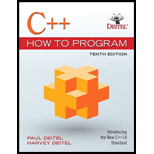
Concept explainers
(Removing Duplicated Code in the main Function) In Fig. 3.9, the main function contains six statements (lines 14-15, 16-17, 26-27, 28-29, 37-38 and 39-40) that each display an Account object's name and balance. Study these statements and you'll notice that they differ only in the Account object being manipulated-accountl or account2. In this exercise, you'll define a new displayAccount function that contains one copy of that output statement. The member function's parameter will be an Account Object and the member function will output the object's name and balance. You'll then replace the six duplicated statements in main with calls to displayAccount, passing as an argument the specific Account object to output.
-
Modify Fig. 3.9 to define the following displayAccount function after the using directive and before main:
void displayAccount(Account accountToDisplay) {
// place the statement that displays
// accountToDisplay's name and balance here
}
Replace the comment in the member function's body with a statement that displays accountToDisplay’s name and balance.
Once you've completed displayAccount’s declaration, modify main to replace the statements that display each Account’s name and balance with calls to displayAccount of the form:
displayAccount(nameOfAccountObject);
In each call, the argument should be the account1 or account2 object, as appropriate. Then, test the updated
Want to see the full answer?
Check out a sample textbook solution
Chapter 3 Solutions
C++ How to Program (10th Edition)
Additional Engineering Textbook Solutions
Introduction To Programming Using Visual Basic (11th Edition)
Database Concepts (8th Edition)
SURVEY OF OPERATING SYSTEMS
BASIC BIOMECHANICS
Fluid Mechanics: Fundamentals and Applications
Java: An Introduction to Problem Solving and Programming (8th Edition)
- whats for dinner? pleasearrow_forwardConsider the follow program that prints a page number on the left or right side of a page. Define and use a new function, isEven, that returns a Boolean to make the condition in the if statement easier to understand. ef main() : page = int(input("Enter page number: ")) if page % 2 == 0 : print(page) else : print("%60d" % page) main()arrow_forwardWhat is the correct python code for the function def countWords(string) that will return a count of all the words in the string string of workds that are separated by spaces.arrow_forward
- Consider the following program that counts the number of spaces in a user-supplied string. Modify the program to define and use a function, countSpaces, instead. def main() : userInput = input("Enter a string: ") spaces = 0 for char in userInput : if char == " " : spaces = spaces + 1 print(spaces) main()arrow_forwardWhat is the python code for the function def readFloat(prompt) that displays the prompt string, followed by a space, reads a floating-point number in, and returns it. Here is a typical usage: salary = readFloat("Please enter your salary:") percentageRaise = readFloat("What percentage raise would you like?")arrow_forwardassume python does not define count method that can be applied to a string to determine the number of occurances of a character within a string. Implement the function numChars that takes a string and a character as arguments and determined and returns how many occurances of the given character occur withing the given stringarrow_forward
- Consider the ER diagram of online sales system above. Based on the diagram answer the questions below, a) Based on the ER Diagram, determine the Foreign Key in the Product Table. Just mention the name of the attribute that could be the Foreign Key. b) Mention the relationship between the Order and Customer Entities. You can use the following: 1:1, 1:M, M:1, 0:1, 1:0, M:0, 0:M c) Is there a direct relationship that exists between Store and Customer entities? Answer Yes/No? d) Which of the 4 Entities mention in the diagram can have a recursive relationship? e) If a new entity Order_Details is introduced, will it be a strong entity or weak entity? If it is a weak entity, then mention its type?arrow_forwardNo aiarrow_forwardGiven the dependency diagram of attributes {C1,C2,C3,C4,C5) in a table shown in the following figure, (the primary key attributes are underlined)arrow_forward
- What are 3 design techniques that enable data representations to be effective and engaging? What are some usability considerations when designing data representations? Provide examples or use cases from your professional experience.arrow_forward2D array, Passing Arrays to Methods, Returning an Array from a Method (Ch8) 2. Read-And-Analyze: Given the code below, answer the following questions. 2 1 import java.util.Scanner; 3 public class Array2DPractice { 4 5 6 7 8 9 10 11 12 13 14 15 16 public static void main(String args[]) { 17 } 18 // Get an array from the user int[][] m = getArray(); // Display array elements System.out.println("You provided the following array "+ java.util.Arrays.deepToString(m)); // Display array characteristics int[] r = findCharacteristics(m); System.out.println("The minimum value is: " + r[0]); System.out.println("The maximum value is: " + r[1]); System.out.println("The average is: " + r[2] * 1.0/(m.length * m[0].length)); 19 // Create an array from user input public static int[][] getArray() { 20 21 PASSTR2222322222222222 222323 F F F F 44 // Create a Scanner to read user input Scanner input = new Scanner(System.in); // Ask user to input a number, and grab that number with the Scanner…arrow_forwardGiven the dependency diagram of attributes C1,C2,C3,C4,C5 in a table shown in the following figure, the primary key attributes are underlined Make a database with multiple tables from attributes as shown above that are in 3NF, showing PK, non-key attributes, and FK for each table? Assume the tables are already in 1NF. Hint: 3 tables will result after deducing 1NF -> 2NF -> 3NFarrow_forward
 C++ Programming: From Problem Analysis to Program...Computer ScienceISBN:9781337102087Author:D. S. MalikPublisher:Cengage Learning
C++ Programming: From Problem Analysis to Program...Computer ScienceISBN:9781337102087Author:D. S. MalikPublisher:Cengage Learning C++ for Engineers and ScientistsComputer ScienceISBN:9781133187844Author:Bronson, Gary J.Publisher:Course Technology Ptr
C++ for Engineers and ScientistsComputer ScienceISBN:9781133187844Author:Bronson, Gary J.Publisher:Course Technology Ptr Microsoft Visual C#Computer ScienceISBN:9781337102100Author:Joyce, Farrell.Publisher:Cengage Learning,
Microsoft Visual C#Computer ScienceISBN:9781337102100Author:Joyce, Farrell.Publisher:Cengage Learning,- COMPREHENSIVE MICROSOFT OFFICE 365 EXCEComputer ScienceISBN:9780357392676Author:FREUND, StevenPublisher:CENGAGE LProgramming Logic & Design ComprehensiveComputer ScienceISBN:9781337669405Author:FARRELLPublisher:Cengage




